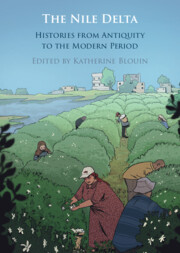Book contents
- The Nile Delta
- The Nile Delta
- Copyright page
- For Mona Abaza
- Contents
- Figures
- Maps
- Tables
- Contributors
- Acknowledgements
- Abbreviations
- 1 Introduction
- 2 Call Me by My Names
- 3 The Nile Delta before the Pharaohs
- 4 The Khetem-Border-Posts in the Delta during the New Kingdom
- 5 New Land amongst New Rivers?
- 6 The Mareotis Area
- 7 From Memphis to Alexandria
- 8 Growing with the Empire? From Village to Town
- 9 Mapping the Cult of Christian Saints in the Nile Delta from the Fifth to the Ninth Century CE
- 10 Alexandria
- 11 Imperial Power, Tribal Settlement and Fiscal Revolts in the Early Islamic Delta (Seventh to Ninth Century CE)
- 12 The Nile as Nexus
- 13 Water and Prices
- 14 Water Development in the Medieval Western Delta
- 15 The Nile Delta in European Cartography, 1200–1800
- 16 Just Passing Through?
- 17 Reclaiming the Archive
- 18 Short Commentary on Accounting Documents from a Vanishing Cotton Estate (ʿIzba) in the Nile Delta
- Index
- References
12 - The Nile as Nexus
The Nilometer at al-Rawda Island between Veneration and Mediation in Medieval Islamic Egypt
Published online by Cambridge University Press: 15 February 2024
- The Nile Delta
- The Nile Delta
- Copyright page
- For Mona Abaza
- Contents
- Figures
- Maps
- Tables
- Contributors
- Acknowledgements
- Abbreviations
- 1 Introduction
- 2 Call Me by My Names
- 3 The Nile Delta before the Pharaohs
- 4 The Khetem-Border-Posts in the Delta during the New Kingdom
- 5 New Land amongst New Rivers?
- 6 The Mareotis Area
- 7 From Memphis to Alexandria
- 8 Growing with the Empire? From Village to Town
- 9 Mapping the Cult of Christian Saints in the Nile Delta from the Fifth to the Ninth Century CE
- 10 Alexandria
- 11 Imperial Power, Tribal Settlement and Fiscal Revolts in the Early Islamic Delta (Seventh to Ninth Century CE)
- 12 The Nile as Nexus
- 13 Water and Prices
- 14 Water Development in the Medieval Western Delta
- 15 The Nile Delta in European Cartography, 1200–1800
- 16 Just Passing Through?
- 17 Reclaiming the Archive
- 18 Short Commentary on Accounting Documents from a Vanishing Cotton Estate (ʿIzba) in the Nile Delta
- Index
- References
Summary
For millennia, Egyptian rulers dedicated vast resources to managing the annual inundation of the Nile, with the mandate to govern Egypt contingent upon the critical responsibility of channelling and gauging the river. These responsibilities encompassed critical administrative, engineering and hydraulic undertakings, from dam construction and canal dredging to precise monitoring of water levels to predict harvests and levy taxes. Yet, this mandate was also contingent upon the veneration of the Nile as both guarantor of Egypt’s prosperity and the conduit of divine grace and God’s agent of reward and punishment. Nile veneration in medieval Islam addressed these symbolic and spiritual aspects, through ceremonies enacted throughout the year centred on the nilometer (al-miqyās) at the island of al-Rawda, which served as supplications to God for a precise level of rising flood waters. Striking a delicate balance between the pragmatic and symbolic necessitated a nuanced response to the ancient practice of Nile veneration, one which had no precedent in Islam. My intention is to examine the interplay and balance between these considerations by analysing the phenomenon of nilometer construction in medieval Islamic Egypt through the lens of Nile veneration between the 7th and 11th centuries CE.
- Type
- Chapter
- Information
- The Nile DeltaHistories from Antiquity to the Modern Period, pp. 421 - 452Publisher: Cambridge University PressPrint publication year: 2024



